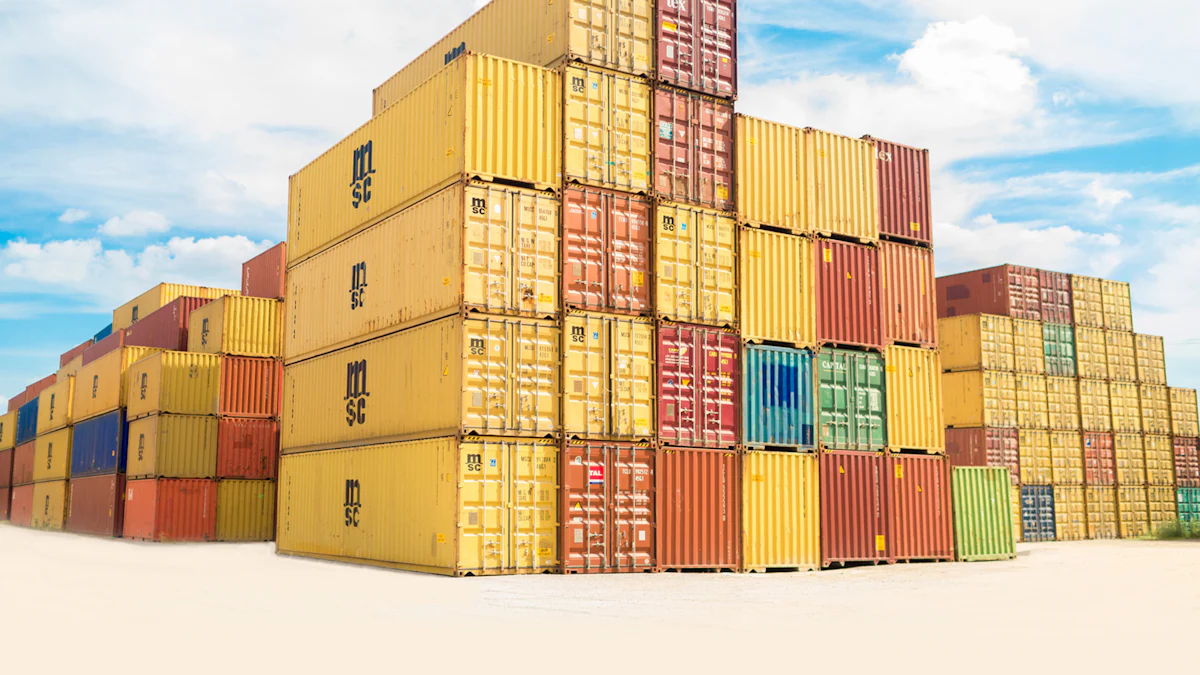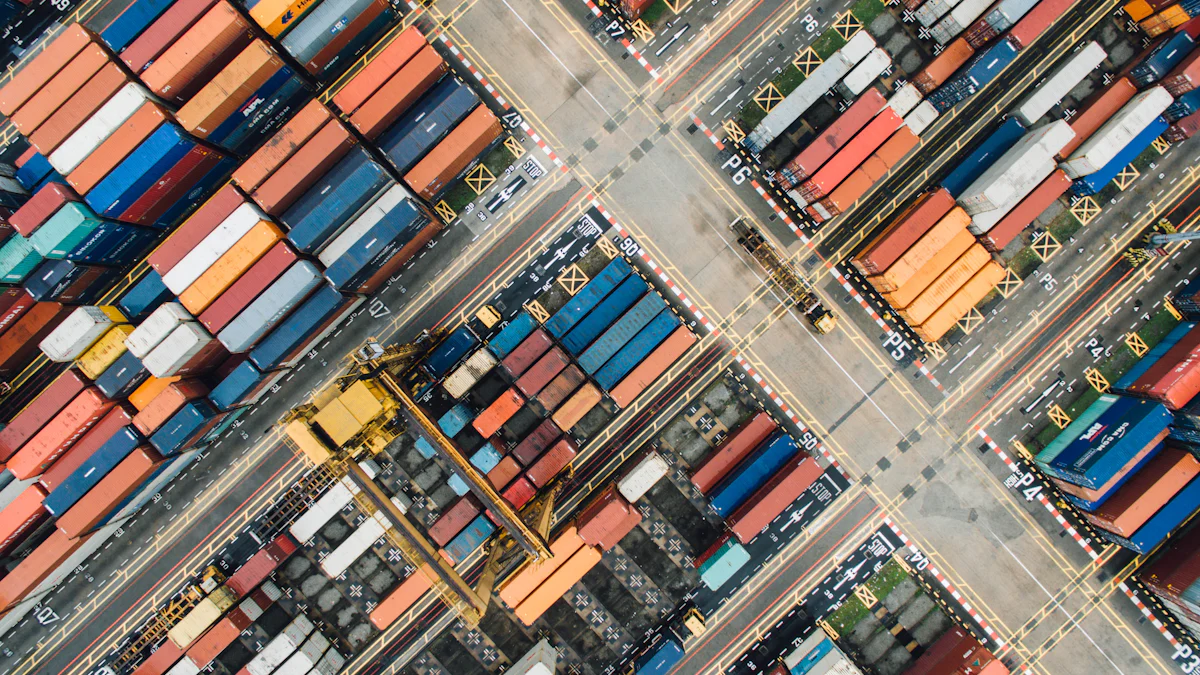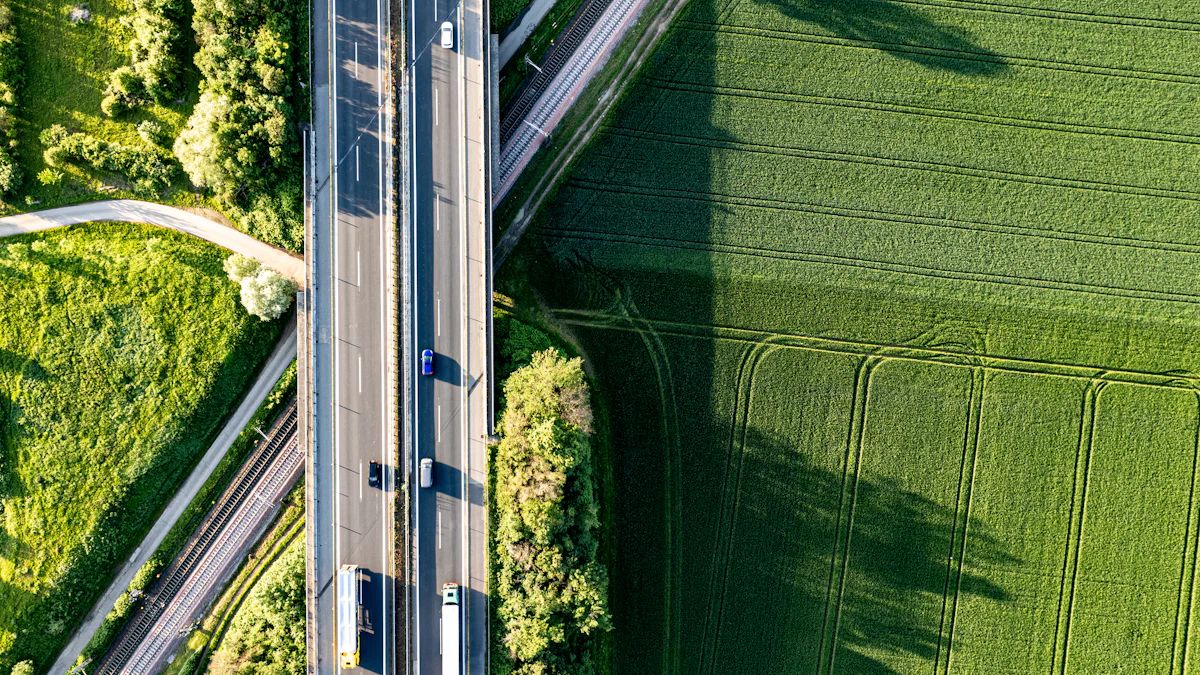Current State of Multimodal Transport Development in India

Multimodal transport combines various modes like sea, air, road, and rail to optimize logistics. This approach minimizes time loss at trans-shipment points and accelerates goods transit. India's logistics sector benefits significantly from multimodal transport. Efficient integration of transport modes reduces documentation burdens and enhances cost-effectiveness. The current landscape in India shows a growing demand for such solutions. Government initiatives and infrastructure development support this growth. Multimodal transport plays a vital role in India's ambition to improve logistics efficiency and reduce costs.
Understanding Multimodal Transport
Definition and Concept
Explanation of multimodal transport
Multimodal Transport refers to the movement of goods using multiple modes of transportation. These modes include railways, waterways, and airways. This approach optimizes the logistics process by providing faster transit of goods. The use of different transport modes reduces the disadvantages of distance from markets. Multimodal Transport also minimizes the tying-up of capital.
Key components and modes involved
Multimodal Transport involves several key components. These components include the integration of various transport modes, such as rail, road, sea, and air. Each mode plays a crucial role in the seamless movement of goods. A single agency usually manages the entire operation. This agency is known as the Multimodal Transport Operator. The operator handles all matters related to the goods. This includes any delays in delivery at the destination. The legal concept of Multimodal Transport is defined in international conventions. These conventions specify the liability regime of the operator.
Historical Context
Evolution of multimodal transport in India
The evolution of Multimodal Transport in India has been significant. The country has seen a shift towards integrated logistics solutions. This shift aims to enhance efficiency and reduce costs. The government has played a pivotal role in this transformation. Initiatives have focused on improving infrastructure and connectivity. Multimodal Transport has become essential for India's logistics sector.
Key milestones and developments
Several key milestones have marked the development of Multimodal Transport in India. The establishment of Multi-modal Logistics Parks (MMLPs) is one such milestone. These parks facilitate the integration of different transport modes. Inland Container Depots (ICDs) have also been developed. These depots enhance the efficiency of goods movement. The Bharatmala project aims to improve road infrastructure. This project supports the growth of Multimodal Transport. The Indian Railways plans to develop Multi-Modal Transport Hubs (MMTH). These hubs will be located in cities with populations exceeding one million. The goal is to facilitate better connectivity across the country.
Infrastructure and Development

Current Infrastructure
Overview of existing facilities
India's current infrastructure for Multimodal Transport includes several key facilities. The country has developed a network of ports, railways, and highways. These facilities support the seamless movement of goods across different modes of transport. Ports handle a significant portion of India's cargo traffic. Railways connect major industrial hubs with ports and cities. Highways facilitate the movement of goods by road. Inland Container Depots (ICDs) play a crucial role in managing cargo. These depots provide storage and handling services for containers. The integration of these facilities forms the backbone of Multimodal Transport in India.
Major multimodal logistics parks
Major multimodal logistics parks have emerged as vital components of India's transport infrastructure. These parks serve as hubs for the consolidation and distribution of goods. They offer facilities for warehousing, packaging, and transportation. Multi-modal Logistics Parks (MMLPs) enhance the efficiency of goods movement. The government plans to establish more MMLPs across the country. These parks aim to reduce logistics costs and improve connectivity. The development of MMLPs aligns with India's goal to become a $5 trillion economy. State governments provide land and subsidies to support these initiatives.
Government Initiatives
Policies promoting multimodal transport
The Indian government has introduced policies to promote Multimodal Transport. These policies aim to streamline the logistics sector and reduce costs. The government focuses on improving infrastructure and connectivity. The Bharatmala project plays a significant role in this effort. This project aims to enhance road infrastructure across the country. The government also encourages private sector participation in logistics. Policies support the development of Multi-Modal Transport Hubs (MMTH). These hubs facilitate better connectivity in urban areas. The government aims to align logistics costs with international standards.
Key government projects and investments
Key government projects and investments drive the growth of Multimodal Transport in India. The Bharatmala project represents a significant investment in road infrastructure. This project aims to improve connectivity between industrial hubs and ports. The Indian Railways plans to develop MMTH in major cities. These hubs will enhance the integration of different transport modes. The government invests in the development of MMLPs across the country. These parks aim to improve the efficiency of goods movement. State governments play a crucial role in providing land and subsidies. These efforts support India's ambition to reduce logistics costs and boost economic growth.
Benefits of Multimodal Transport
Economic Advantages
Cost efficiency and savings
Multimodal Transport offers significant economic benefits by enhancing cost efficiency. The integration of various transport modes reduces the burden of documentation and formalities. This streamlined process leads to faster transit of goods, minimizing time loss at trans-shipment points. Businesses can save costs by dealing with only one agency for transportation needs. Multimodal Transport also reduces the cost of exports, making Indian products more competitive in the global market. The reduction in logistics costs aligns with India's goal to lower logistics expenses from 14% of GDP to below 10%.
Impact on trade and commerce
The impact of Multimodal Transport on trade and commerce is substantial. Efficient logistics solutions facilitate smoother movement of goods across borders. This efficiency boosts trade volumes and enhances India's position in international markets. Multimodal Transport supports the seamless integration of supply chains, leading to improved reliability and predictability in delivery schedules. Businesses benefit from reduced transit times, which enhances customer satisfaction and strengthens trade relationships. The development of multimodal logistics parks further supports trade by providing centralized hubs for goods distribution.
Environmental Benefits
Reduction in carbon footprint
Multimodal Transport contributes to environmental sustainability by reducing the carbon footprint associated with logistics. The use of railways and waterways as part of the transport mix leads to lower emissions compared to road transport alone. This shift towards more sustainable modes of transport aligns with global efforts to combat climate change. The reduction in carbon emissions not only benefits the environment but also enhances the reputation of businesses committed to sustainable practices. Multimodal Transport plays a crucial role in promoting eco-friendly logistics solutions.
Sustainable transport solutions
Sustainable transport solutions are a key advantage of Multimodal Transport. By integrating different modes of transport, businesses can optimize routes and reduce fuel consumption. This optimization leads to more efficient use of resources and supports the transition to greener logistics practices. Multimodal Transport encourages the adoption of innovative technologies that further enhance sustainability. The focus on sustainable transport solutions aligns with India's commitment to achieving its environmental goals. The development of infrastructure that supports Multimodal Transport is essential for creating a sustainable logistics ecosystem.
Challenges and Solutions
Current Challenges
Infrastructure bottlenecks
India faces significant infrastructure bottlenecks in the development of Multimodal Transport. The existing transport network struggles to meet the growing demand for efficient logistics solutions. Ports, railways, and highways often experience congestion. This congestion leads to delays in the movement of goods. Many facilities lack modern equipment and technology. This deficiency hinders the seamless integration of different transport modes. The absence of adequate infrastructure impacts the overall efficiency of Multimodal Transport.
Regulatory and policy hurdles
Regulatory and policy hurdles present another challenge for Multimodal Transport in India. Complex regulations govern the logistics sector. These regulations create barriers to the smooth operation of multimodal systems. Different transport modes fall under the jurisdiction of various authorities. This fragmentation leads to inconsistencies in policies and procedures. The legal framework for Multimodal Transport requires alignment with international standards. The United Nations Convention on the International Transport of Goods provides guidelines for the liability regime of operators. However, India needs to harmonize its policies with these international conventions.
Proposed Solutions
Strategies for infrastructure improvement
Strategies for infrastructure improvement can address the challenges faced by Multimodal Transport. Investment in modernizing ports, railways, and highways is essential. Upgrading facilities with advanced technology will enhance the efficiency of goods movement. The development of Multi-modal Logistics Parks (MMLPs) should continue. These parks serve as hubs for the consolidation and distribution of goods. State governments can play a crucial role by providing land and subsidies for these projects. Collaboration between public and private sectors can accelerate infrastructure development.
Policy reforms and innovations
Policy reforms and innovations are necessary to overcome regulatory hurdles in Multimodal Transport. Simplifying regulations will facilitate smoother operations across different transport modes. A unified regulatory framework can ensure consistency in policies and procedures. Aligning India's legal framework with international conventions will enhance the credibility of Multimodal Transport. Encouraging private sector participation can drive innovation in logistics solutions. The government should focus on creating an environment that supports the growth of Multimodal Transport. These efforts will contribute to reducing logistics costs and boosting economic growth.
Future Prospects

Emerging Trends
Technological advancements
Technological advancements drive the future of Multimodal Transport. Automation plays a crucial role in improving efficiency. Automated systems streamline operations at ports and logistics hubs. These systems reduce human error and increase speed. Artificial intelligence enhances decision-making processes. AI algorithms optimize routes and schedules for better performance. Blockchain technology ensures transparency and security in transactions. Blockchain records provide an immutable ledger of all activities. This technology builds trust among stakeholders in the supply chain.
Digital platforms facilitate seamless communication between different modes. These platforms integrate information from various sources. Real-time data sharing improves coordination and reduces delays. Internet of Things (IoT) devices monitor the condition of goods during transit. IoT sensors track temperature, humidity, and location. This information helps maintain the quality of perishable items. The adoption of electric vehicles supports sustainable transport solutions. Electric trucks reduce emissions and lower operational costs. The use of drones for last-mile delivery is gaining traction. Drones offer faster and more efficient delivery options.
Integration with global supply chains
Integration with global supply chains is essential for Multimodal Transport. Globalization increases the demand for efficient logistics solutions. Multimodal Transport connects domestic markets with international partners. This connection enhances trade opportunities and economic growth. Standardization of procedures facilitates smooth cross-border operations. Harmonized regulations ensure consistency in documentation and compliance. International collaborations strengthen the global logistics network. Partnerships with foreign companies bring expertise and innovation.
The development of multimodal corridors boosts connectivity. These corridors link major economic zones across regions. Improved infrastructure supports the movement of goods over long distances. The expansion of trade agreements opens new markets for Indian products. Free trade zones provide incentives for businesses to invest. These zones offer tax benefits and simplified customs procedures. The integration of Multimodal Transport with global supply chains enhances competitiveness. Businesses gain access to a wider customer base and diverse resources.
Vision for the Future
Long-term goals and objectives
Long-term goals for Multimodal Transport focus on sustainability and efficiency. The government aims to reduce logistics costs to international standards. Lower costs improve the competitiveness of Indian products in global markets. Infrastructure development remains a priority for achieving these goals. Investment in modern facilities enhances the capacity of transport networks. The establishment of more Multi-modal Logistics Parks (MMLPs) supports consolidation efforts. These parks serve as central hubs for the distribution of goods.
The promotion of green logistics practices aligns with environmental objectives. The shift towards eco-friendly transport modes reduces carbon emissions. Renewable energy sources power logistics operations. The adoption of electric vehicles contributes to cleaner air. The government encourages research and development in logistics technology. Innovation drives the creation of new solutions for complex challenges. The vision for the future includes a robust and resilient logistics ecosystem. This ecosystem adapts to changing market demands and technological advancements.
Potential impact on India's economy
Multimodal Transport has a significant impact on India's economy. Efficient logistics solutions boost trade volumes and economic growth. The reduction in logistics costs increases profit margins for businesses. Improved connectivity enhances the competitiveness of Indian industries. The creation of jobs in the logistics sector supports economic development. Skilled workers contribute to the growth of the industry. The expansion of infrastructure attracts foreign investment. Investors seek opportunities in a well-connected market.
The integration of Multimodal Transport with global supply chains strengthens India's position in international trade. Access to new markets diversifies revenue streams for businesses. The development of export-oriented industries increases foreign exchange earnings. The government benefits from increased tax revenues from thriving businesses. The overall improvement in logistics efficiency enhances the quality of life for citizens. Consumers enjoy faster delivery times and lower prices for goods. The potential impact of Multimodal Transport on India's economy is transformative.
Multimodal Transport in India has transformed the logistics landscape. The integration of various transport modes optimizes cost efficiency and reliability. Multimodal Transport reduces documentation burdens, saving costs for businesses. Government initiatives and infrastructure developments support this growth. The future of Multimodal Transport in India holds promise. Technological advancements and global supply chain integration will drive progress. Stakeholders must collaborate to overcome challenges. Infrastructure improvements and policy reforms are essential. Multimodal Transport will enhance India's economic competitiveness. A collective effort will ensure sustainable and efficient logistics solutions.
See Also
Revolutionizing Transport with Indigenous Smart Solutions
Ready to Dive into Cutting-Edge Transport Tech for Supply Chains
Ready for the Transport Tech Revolution Ahead?
